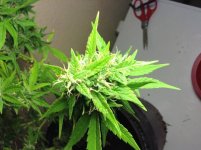Organic feeding can increase flavor though that will be disputed, most important thing is to flush and not overfeed when using chem feed. Decently grown organic buds are about as good as decently grown chem buds, the difference is people using chems are IME, in it for the money and try to push the plants harder to yield more, thus overfeeding and fucking up the delicate flavours. Also you tend to need less pesticides and other chems because the plant has good defenses.
If you are new to organics there are a lot of good organic/bio bottle feeds out there which are just as easy as the chemical feed. I wouldn't recommend using compost tea to feed the plant in your situation. As far as I know, compost tea is mostly used to replenish and activate the bacteria in the soil to break down organic food in the soil, and add some hormones and vitamins to boost growth.
The bottled organic feeds contain most of what people put in compost tea, but the NPK is calculated and stable so should give you no problems feeding your plants with this.
If you are new to organics there are a lot of good organic/bio bottle feeds out there which are just as easy as the chemical feed. I wouldn't recommend using compost tea to feed the plant in your situation. As far as I know, compost tea is mostly used to replenish and activate the bacteria in the soil to break down organic food in the soil, and add some hormones and vitamins to boost growth.
The bottled organic feeds contain most of what people put in compost tea, but the NPK is calculated and stable so should give you no problems feeding your plants with this.




